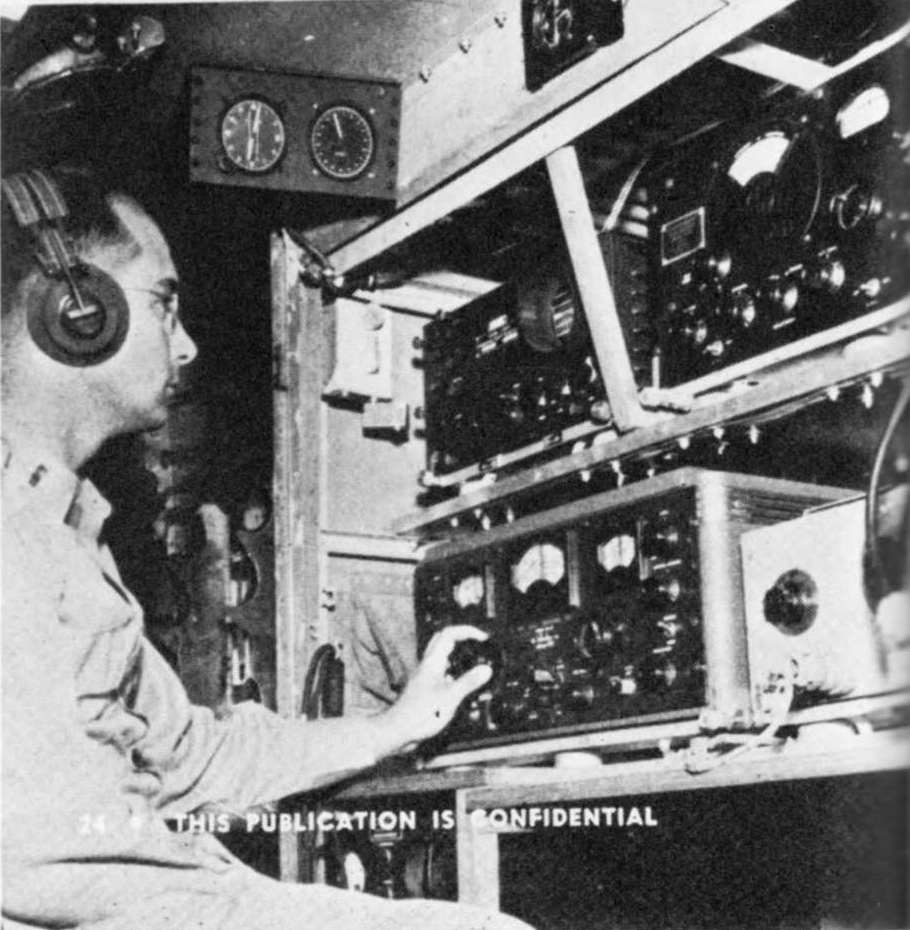The desperate months...
Early 1942 found the US in a sad situation, both from a strategic standpoint and from the standpoint of
advanced tools required to be effective on the battlefield. Most of the equipment that they possessed was from the
1930s, and technology was rapidly passing us by. Because of the need to understand the electronic threat
against us, we followed the example of the British - who after all had been doing it for two years - and
pressed into service what we had. This bay shows the basics of that capability, reflecting a photograph
of an installation in an early Pacific theater B-24 ferret aircraft of the time, shown below:

Early signal collection equipment. This included a BC-1031 or BC-1032 panadapter, Hallicrafters S-27 and SX-28 receivers, and a rudimentary
pulse analysis capability formed through the use of a 1930's Dumont "oscillograph" and an HP audio oscillator.
Above the operator's head in this photo is a magnetic compass repeater indicator on the left, driven by the flux gate compass in the wing of
the aircraft. To its right is a slave indicator that provided directional information from the AN/APA-24 rotatable Yagi
antenna that was mounted outside the fuselage. By correlating data from the two, the operator could determine the direction
of a target signal received on the Hallicrafters S-27 VHF receiver mounted to the far top right in front of the operator.
The panoramic adapter to the left of the S-27 is a BC-1031 with a 455kHz IF input, judging from the gaze of the operator and
his tuning of the Hallicrafters SX-28 beneath the BC-1031. Alternatively, an outwardly identical BC-1032, with a 5.25MHz IF input,
was carried whenever some a form of spectrum visualization was needed for the S-27 scanning. To the right of the SX-28 is a portion
of a Hewlett Packard 200-B audio oscillator, initially used with a Dumont 224-A 3" oscilloscope for accurate radar pulse repetition
rate determination. The 224-A was normally installed to the right of the 200-B in other photos of the time, but this later photo shows its
replacement, the AN/APA-6 pulse analyzer, in a rather user unfriendly
mounting position beneath the SX-28.
The shock mounts for all the pieces above were custom made. They used the model of the ARINC 404 specification, except they had to be
widened and shortened on an individual basis for each piece of commercial equipment. Note the set of six shock mount elements under the
S-27 and SX-28...these buggers are heavy! All of the later military repackaging of this equipment used the ATR (Austin Trumbull Radio)
portion of the specification, modified by the military to their own peculiar system. The standard "single ATR" became the "B1-D1" size in
milspeak. Countermeasures equipment embraced this model almost exclusively from the start, probably because it was realized quite
early that equipment was going to require rapid insertion and deinstallation for each mission.
At upper left in the photo below is an audio oscillator that was used to characterize pulse repetition rates. Initially this
Hewlett Packard oscillator was bought and used in the original gray wrinkle finish version of the HP 200-B seen above, but as time went
on, a specialized model was produced that had the regulation black wrinkle finish, in addition to being shock mounted and cabled
specifically for countermeasures work - the rare O-10/APA-6X shown below.
At the far right is a Dumont 224-A oscilloscope used
to display Lissajous figures, using the receiver audio output and the HP oscillator output as x and y inputs. Comparing the number of lobes
on the Lissajous trace with the frequency indication on the oscillator would reveal the pulse repetition rate to a fair degree of accuracy.
The box in between is a Navy RL-7 interphone amplifier awaiting disposition to a more suitable location in the "flight deck."

Early signal collection equipment in a modern setting. (The AN/ARR-15 receiver at lower right is not a part of the early ECM gear - it just fits
conveniently there next to an AN/ART-13 transmitter unseen in the rack to its right.)
On the next shelf down is a BC-1032 panoramic adapter, designed to be used with the Hallicrafters S-27/S-36 receiver
to its right. This particular receiver was labeled an S-36M, the modification being an SO-239 connector on
the left side of the set to feed the panadapter. It is unusual in another sense as well - for a brief period
Hallicrafters had reportedly not had time to stamp a tuning dial faceplate with the new S-36 designation on it, so
this one and a limited number of others had the new circuitry and the old S-27 faceplate.
Both the S-27 and SX-28 receivers above did not last long in USAAF aircraft service, and were rather speedily reworked and repackaged into ATR aircraft
configurations as the AN/ARR-5 and AN/ARR-7 shown here .
Elimination of the bandspread tuning and the heavy push pull audio stage reduced weight in these aircraft versions significantly. The ARR-5 and ARR-7
acquisition contract also forced Hallicrafters to install an extra RF isolation stage to reduce local oscillator bleed-through to the antenna, but the execution of
this specification was sadly lacking and mostly just introduced additional broadband noise at the expense of the perceived detection prevention.
An unauthorized mica capacitor jumper between grid and plate pins of the isolation tube (with removal of the tube) improves reception tremendously...heh.
Hallicrafters took the opportunity to introduce some minor circuit improvements in these airborne sets, which incidentally showed up in the S-36 and SX-28A which
continued to be purchased for ground installations, but the isolation stage (which was intended to prevent enemy tracking of aircraft emanating such local oscillator
signals) was not one of them.
Return to AAFRadio

